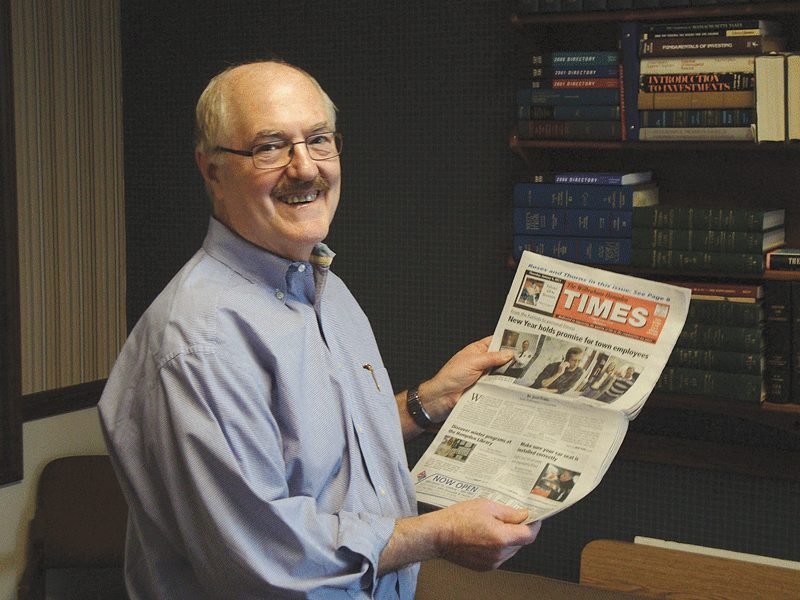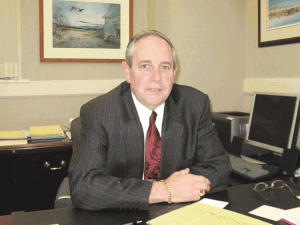
Lending Support
How Do Banks Decide Where to Direct Their Charitable Giving?

Tom Brown says bank executives and employees see charitable giving as part of their corporate responsibility.
There’s a good reason why many nonprofits and other local causes approach banks for funding, said Tom Brown.
“That’s where the money is.”
But, more important, banks have also long established themselves as reliable, go-to donors for a host of community endeavors. Most banks have established foundations for that purpose and are required by law to donate at least 5% of those assets annually.
“The commitment of all the community banks in the Valley is important,” said Brown, senior vice president of retail banking at Easthampton Savings Bank (ESB). “In so many local projects, you’ll see that some bank is a lead sponsor. All community banks take that as our corporate responsibility.”
And the need, according to administrators at several area banks, has never been greater.
“This is a subject near and dear to my heart,” said Rick DeBonis, senior vice president of marketing at Hampden Bank. “We do a lot in the community with respect to supporting in terms of money and in terms of sweat and rolling up our sleeves. We’re very involved.
“We get requests on a daily basis, coming to me or someone else in the organization,” he continued, noting that banks must develop strategies to sort through what is often a sea of pitches. “We have certain guidelines we use, the first of which is the relevance to the bank’s mission statement and our overall objectives as a community bank.”
That means supporting causes that have a direct impact on the greatest number of area residents, said DeBonis, noting a few examples, including schools, youth athletic programs, and, increasingly, cultural events. “We’re looking for not just nonprofits, but things that bring the community together and could have a psychological benefit as well as a financial benefit, in many cases. It’s a broad spectrum of organizations and activities, and we are happy to be a part of it.”
Dena Hall, vice president of marketing and community relations at United Bank, said her institution focuses on specific areas of interest when sorting through grant requests, specifically education, health and human services, youth programs, and cultural programs.
“We will entertain proposals and review the proposals as a group and make decisions whether to fund it,” she said of United, which operates a foundation worth $5.5 million at last count — meaning a minimum annual disbursement of $275,000 to qualified nonprofits — and also a community-sponsorship budget that makes smaller donations to area causes and events.
In either case, “the organization has to operate in the communities we serve, and there are certain things we will not fund” — salaried positions, for example, seeing that the typical United grant of $5,000 to $10,000 wouldn’t cover a significant amount of a paycheck.
However, there have been larger contributions, including recent support of Baystate Medical Center’s ‘Hospital of the Future’ expansion project. “We felt the scope of that project was wide,” Hall said, and it covers a lot of the same areas where our customers live, and we felt it would benefit our customers in the region we serve, so we participated in this great campaign to give our region a wonderful new hospital.”
Doug Burr, senior vice president and director of marketing at Florence Savings Bank, said his bank’s giving is reflective of the communities it serves, so it contributes to 501(c)3 groups that do business in its market.
“We feel we should take on community needs,” he said. “We can’t take on national and international needs; we can’t make a difference there, but we certainly can make a significant impact here in the local community — with a local hospital, a local library, a local school. And we feel good about that.”
For this issue, BusinessWest visits several local banks to discover how they decide how to distribute a finite amount of money to deserving organizations — and why they consider it a crucial part of their community mission.
Getting the Vote Out
“Because of who we are and the fact that we’re a mutual bank, here since 1873,” Burr said, “one of our core principles really is community giving and taking care of our customers. We’ve always said that, being a mutual savings bank, we pay our dividends back to the community because we don’t have stockholders.”
With that reputation, he told BusinessWest, Florence Savings Bank is typically one of the first doors to get knocked on by organizations looking to boost capital campaigns or fund drives.
“Because we’re a local, community bank, we don’t have a really formal process for our giving program,” he said. “People who have a need sit down and talk to me, the guy that makes the actual decisions. That face-to-face can’t always be done in larger organizations, and it’s a real benefit.”
Nine years ago, FSB took that informal approach a step further, launching a program called Customers’ Choice Community Grants. That effort allows the bank’s customers to vote a share of $50,000 to their favorite local organizations, agencies, and schools. The money is allocated by percentage of votes; every organization that gets 1% of the vote gets a percentage of the money.
That often results in some good-natured lobbying among agency leaders, school principals, and others to persuade FSB customers to throw them a few votes — which, of course, serves as free advertising for the bank.
Burr said he and President John Heaps developed the idea as a way to determine if the bank’s giving patterns matched community priorities. For the most part, that has proven to be the case.
“It validated a lot of the giving we did in the past,” Burr said. “When I look at the top 100 vote-getters, they’re all organizations we’re familiar with and have helped. At first, I was amazed how many nonprofits are in our area — about 300 each got a vote — and it kind of answered our question, are we doing what customers would want us to do?”
The bank uses that data to shape the direction of its larger donations, he added, but it has also drawn new retail customers who appreciate the way the bank connects with its market communities through the voting program.
“It’s a powerful thing,” Burr said. “In one sense, it’s the right thing to do, but it’s also powerful from a business-development perspective. And our employees feel good about the bank supporting these organizations; this is their home, and we’re helping our friends and neighbors as well as our customers.”
Narrowing the Field
All banks have to develop strategies for distributing philanthropic dollars, and many, like United and Hampden, narrow their focus to a few areas of interest.
“One of the biggest questions is, what has the potential to positively impact the community in the broadest way; what affects the most people?” DeBonis said, noting that his bank gets input not only from the organizations themselves, but in many cases from employees who sit on their boards.
“Mix all these together, and we make decisions as to what makes the most sense. Like I’ve said, the need has never been greater, and we have found that we cannot say yes to everybody; there have to be some particular guidelines with respect to how we allocate those funds.”
Brown, at ESB, agrees.
“It begins with requests, which come in from a lot of different sources,” Brown said. “We try to focus on local organizations, and for us, the three predominant areas of our contributions would be education, human services, and arts programs. But the focal point is local; we’re not usually contributing to large, national organizations, but instead local, grassroots, homegrown entities within our market.”
The other priority is an organization that will benefit a large group of people, he added. That opens the door to some national agencies, like the United Way, that support a wide range of local constituencies, but still leaves room for annual support of efforts like sports teams and school yearbooks, as well as one-time community events.
“When the town of Hadley had its 350th, we were major sponsors of that,” Brown said. “When Easthampton has its bear festival, we’re major sponsors of that. If a community is building a new playground, we may decide to sponsor that. We’ve always looked at this as our community dividend. It’s our responsibility, as a community bank, to give back.
“And it’s not always just about money,” he was quick to add. “Most of our 170 employees are involved in some way with some organization in the community, with a wide range of activities, from raking and shoveling on cleanup day to serving as a board chair or board member. Many organizations have told us that’s as important as writing a check. If you look at the employees of the bank, from the president to the tellers, you’ll find them active in the communities in which we operate.”
Stretching the Dollars
Hall said she and other decision-makers want to be sure that United Bank’s charitable efforts benefit the largest group of constituents and that the projects it funds are viable. “We’re never the only funder, but we’re looking for organizations with multiple funders and track records of success.”
Although United has funded and will fund smaller organizations with smaller grants, she said, it focuses mainly on organizations that can make a long-term impact on its communities — for example, funding a new emergency-rescue vehicle for the Red Cross, afterschool programs at the YMCA, or textbooks for Ludlow schools’ ‘literacy closet.’
Like many banks, Hall makes a point of sharing news of such grants in United’s publication, Yankee Connections, which only leads to further requests. “When it comes out, I get calls from organizations asking, ‘can I get your guidelines?’” She has also moved to communicating giving news on the bank’s Facebook page. “I feel like we’re talking to a whole new group of nonprofit organizations by publishing there.”
Which, of course, only leads to more decisions to make. While Hampden Bank was recently honored by the Western Mass. Assoc. of Fundraising Professionals with its 200 Outstanding Philanthropic Corporation award — for its support of Mercy Medical Center’s ICU and surgical center projects, among other efforts — DeBonis lamented that more worthy causes exist than the bank can support, even just in its market communities.
“There are some things out there that we’d love to fund and sponsor, but we have to look realistically at the cost of participation in relation to the overall dollars available,” he said.
He and others who spoke with BusinessWest understand all-too-clearly that the sluggish economy, just now emerging slowly from a crippling recession, has put the squeeze on nonprofits and other charitable causes, and the size of the average request has grown.
“It’s important for everyone to realize that every bank has a limit on what they can give away,” Brown said. “We try to meet these needs, but we’re trying to spread around a finite number of dollars. It’s not a bottomless pit of money, and we’re trying to be as equitable as we can and fair to everyone.”
These days, that’s just part of what it means to be a community bank.
Joseph Bednar can be reached at [email protected]






